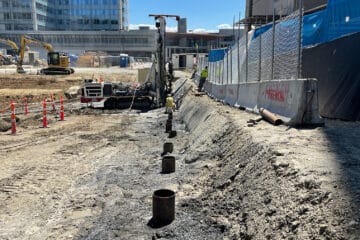
Author: Alfred Jones, PE – Director of Geotechnical Services
A micropile is a small-diameter, drilled-in-place deep foundation that is generally installed by advancing steel casing with a drill rig and creating a bond zone beyond the depth of the casing. A threaded steel center bar is then installed to the bottom of hole and the entire bar is fully grouted along its length.
Micropiles have been around since the 1950’s, although it is only over the last 20 to 30 years that their use has become extremely prevalent. Micropiles can be used to support large buildings, bridges, and even provide support of excavations. There are several reasons why I like micropiles as a go-to deep foundation alternative.
Reason #1: Load Testing – Load testing is relatively easy to perform on a micropile because tension load tests can be performed by pulling on the threaded center bar. A reaction frame or reaction piles are not required as the ground acts as the reaction. These tests are consequently quicker to perform and much less expensive than compression load tests on other deep foundations where either reaction piles or reaction blocks are necessary. The pile bond lengths can be adjusted depending on the load test results, saving a client unnecessary cost. Additionally, due to the simplicity of the test, proof testing is often performed on production piles to further confirm pile capacities.
Almost half of the static load tests I have monitored on various pile types throughout my career did not attain their expected capacity. This is why I put the ability to easily load test at the top of this list.
Reason #2: Small Equipment – Equipment used to install micropiles can be small enough to allow installation indoors or in low headroom environments such as beneath bridges or beneath overhead utility lines. The drill rigs are also lighter which can help with drilling adjacent to retaining walls or excavations. This versatility allows micropiles to be used in situations that many other deep foundations can’t.
Reason #3: Can Get Through Anything – Micropiles are a drilled foundation that have the capability to penetrate most obstructions including cobbles, boulders, concrete, and even metal in some cases. Obstructions are a concern for the installation of almost all other non-shallow foundation types including driven piles, drilled shafts, and even ground improvement. When utilizing micropiles on a project, you’ll take comfort in knowing that obstructions should not significantly impact your project and you will not be subject to the associated change orders that other foundation systems would when encountering obstructions.
Reason #4: High Capacity – Micropiles can obtain extremely high capacity in certain bearing conditions through skin friction. Capacities of roughly 500 tons can be obtained by micropiles with bond zones that are embedded into a strong rock. High capacities (up to about 100 tons) are also possible in some dense soils like glacial till.
Reason #5: Versatility – Lastly, micropiles are extremely versatile. They come in many different casing sizes and thicknesses, and the threaded center bar can be as large as almost 4 inches in diameter! A smaller casing can be installed within a larger-diameter exterior casing to increase vertical capacity and moment resistance. They can be installed at a batter to increase lateral load resistance and can be used under both compression and tension. They are ideal in areas where vibrations are a concern and can even be installed through existing bridge abutments to increase load capacity. There really aren’t many instances where micropiles cannot be used.
These are five very strong reasons to use (or at least consider using) micropiles on your next project. However, I’d be remiss if I didn’t mention some of the drawbacks of micropiles. First, they tend to be one of the most expensive deep foundation types and sometimes casing sizes and wall thicknesses are not readily available. Also, significant spoil is often generated from the drilling and grouting process that may require special disposal. Finally, they take longer to install than other deep foundation types. Because of these reasons, there are many applications where micropiles don’t make sense, but they are certainly one of my go-to foundation types when evaluating a site for deep foundations.